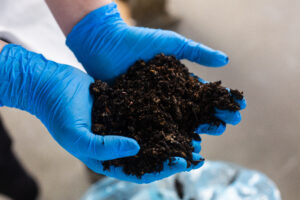Bio-fertilizers – the Natural Way to Feed the Planet
The fertilizer industry will be unrecognizable in 30 years’ time. Currently, nitrogenous fertilizer production contributes 3% of worldwide GHG emissions and uses 3% of global methane supplies. Global overuse of synthetic nitrogen and extractive phosphate fertilizers have created over 500 environmental deadzones through run-off. To compound this, yields of key crops are stagnating or declining where soil health is degrading, while at the same time the planet requires a 2.2% increase in global yield year-on-year in order to feed its growing population. Microbes will be part of the solution.
What is a microbial fertilizer?
Microbial fertilizers function in two ways. Microbes either symbiotically invade the plant increasing its ability to take in and create nutrients, or the microbe stimulates the creation of nutrients in the soil that are more bio-available to the plant. The second group forms a major part of what are known as biostimulants.
Microbial Innovation Business Models
I recently spoke with Maureen Mazurek of Newleaf Symbiotics, a developer of agricultural biologics called M-trophs. She outlined their three go-to-market strategies for microbial crop inputs.
- The company has a product pipeline stretching to 2022 with 15 m-troph based formulations marketed under the brand Terrasym. Five products (two in soy, two in corn, and one in peanuts) are already launched. These microbes have been selected using machine learning to identify which m-troph out of their portfolio of 12,000 generate the required outcome in yield, resilience, or fertilizer uptake.
- Newleaf intends to form engineering partnerships, such as the recent agreement with Joyn Bio. Newleaf’s m-troph microbes were identified as the most effective vehicle for delivery of microbes developed by Joyn. In this arrangement, Newleaf will manufacture the microbe, using process developed in-house, and take royalties on sales of Joyn Bio’s product.
- The company will also license individual strains or m-trophs to crop input developers. This arrangement is attractive to corporate partners, as Newleaf’s innovations can act as bio-compliments to products already in their sales portfolio. Newleaf is exploring ways in which m-trophs can be added to existing products to increase efficacy and reduce environmental impact. In a market where it typically costs $300 million and ten years to bring a crop input to market, this offers incumbents the opportunity to innovate on a much shorter timescale and at a reduced cost.
There are very few microbial developers that will try to build a sales force and distribution network themselves due to high risk and cost. These innovators will have to interact with one of the large international crop input companies. To meet global demand, these companies will have to work with Bayer, Syngenta, Corteva, or the challengers to these crop input incumbents such as Indigo and Farmers Business Networks, as channel partners.
The Moonshot: Genetically Modified (GM) Microbial Fertilizers
The leading start-up in the field of genetically modified microbial products is Joyn Bio. Speaking to Michael Miille, CEO, the key challenge is developing a microbial product so effective that it is able to overcome the significant challenge of bringing a genetically engineered product to market.
The company is a $100 million joint venture between Ginkgo Bioworks and Bayer’s Leaps program. For Bayer, its Leap’s programme has set up a number of moonshot projects in areas such as cancer research and genetic therapies. For Ginkgo, this was a good fit for their microbial factory platform that enables high throughput of DNA synthesis and microbial engineering using automated bioreactors to study and engineer nitrogen fixing bacteria. Ginkgo have created similar spin-outs that use its technology, such as Motif FoodWorks.
Joyn is looking to reduce the amount of fertilizer used in agriculture by discovering microbes that colonize a plant in a symbiotic way. The company is looking for microbes that can then carry the genetically engineered trait into the plant itself, in Michael’s words: “they become the chassis, the Fedex trucks, that deliver different payloads into the plant. These payloads can include nitrogen fixation, address disease, increase hardiness, or anything else that is genetically possible.” Joyn is aiming to engineer a microbe that can improve crop yields 10 times, rather than just searching through a catalogue of naturally occurring microbial traits and turning each into a product that may only deliver 5%-6% yield improvements.
Hurdles for GM Microbial Fertilizers– Regulation and Social Acceptance
As this is an engineered microbe, there are significant regulatory hurdles to clear. This has kept the number of competitors in the GM innovation space very low. In the US, the EPA has a clear path to register a GM product, but it still requires a complete safety and data package. If you go to the other large markets of Brazil or China there is no clear path for an engineered microbe. Companies we spoke to were clear countries in the European Union are unlikely to allow genetically engineered agricultural inputs in this century.
One lesson learned from the experience of Monsanto’s introduction of GM crops 25 years ago is that you do not only have to convince growers that this is a great product, you need to convince the consumer. When you have spent ten years and $300 million developing a product, it is tempting to focus only on how to sell to your customer, the farmer, and not to engage with your end-consumer. Perhaps a lesson can be learned from the success of plant-based protein companies such as Impossible Foods, which uses genetic engineering in one production step, on how to control the marketing message.
The Near-term: Machine Learning to Select Naturally Occurring Microbes
Natural microbial fertilizers have been available for decades. However, adoption has been hampered due to issues with efficacy and shelf life. With efficacy, lab results have often not matched real-world results, as the varying conditions in agricultural settings are not ideal for living organisms. With shelf-life, a shelf stability of around 2 years is an industry minimum, and earlier products experienced too steep a drop in potency over that time.
New technology is enabling more effective microbial fertilizers. Faster trait discovery using machine learning and automated laboratory systems is coupled with quicker and cheaper genomic sequencing technology. This accelerates the discovery of new microbes and the isolation of new genetic traits. Some leading innovators that are already bringing products to market using these technologies include:
- AgBiome, a developer of a microbe trait discovery platform to discover microorganisms and proteins that kill insect pests, fungal pathogens and weeds.
- Pivot Bio, developer of PROVEN, a microbial nitrogen fixation field treatment that adheres to plant roots.
- Locus Agricultural Solutions, a developer of fermentation technology and soil probiotics that increase soil carbon sequestration and crop productivity.
Death in the supply chain
As microbes are living organisms, to retain efficacy shipping can require a controlled environment or even refrigerated shipping. This has limited microbial fertilizers to high value applications such as domestic lawn products and specialty crops.
A more promising solution for the fertilizer commodity market comes from 3Bar Biologics. The company develops on-site fermentation of microbial fertilizers. Using a two-chamber system, the farmer can release the microbes into a growing solution when he is ready to use the product, and it is ready to use in 24 hours. This increases the shelf life of up to one year before the two chambers are mixed, and up to a month after the microbes are re-invigorated. The company’s growth model is to partner with microbial developers to develop custom packaging solutions. 3Bar can also manufacture the microbe itself as part of the packaging service. It does not take any ownership of the organism itself. Most recently, the company announced a partnership with Pivot Bio to manufacture, package, and ship Pivot’s flagship product PROVEN.
Competition
A company like Corteva will require two years of testing the product before they put it into their sales portfolio. This increases the likelihood of incumbent corporates engaging with start-ups early in in the development cycle. Most recently, Corteva made an investment in Lavie Bio, a company spun out by Evogene, whilst also folding in its DuPont’s 2015 acquisition of Taxon Biosciences. Similarly, Michael Miille see’s Joyn Bio’s key competitive edge is having built-in access to Bayer’s R&D facilities and its sales pipeline.
Large corporate R&D departments will struggle to develop microbial solutions internally because they cannot payback on a short enough timescale where a typical target is 24 months. At Monsanto, it was well understood that that chemical inputs are facing headwinds and research into biological solutions is required. This led Monsanto to invest early in companies like Newleaf Symbiotics, as well as acquiring Novozymes biological portfolio in 2013. We expect to see more open innovation activity in this field.
Go-it-alone microbial innovators are exceptions, but one example is Indigo. Their microbial treated seed products are marketed directly to farmers, but this only affects the germination stage and does not play in the field treatment/fertilizer space.
The GM vs. non-GM competition will play out over decades, not years. In the short term, non-GM products will continue to pilot their products with farmers, increase efficacy, and reduce death in the supply chain. These companies will work with existing distribution networks of incumbents such as Syngenta/ChemChina, Corteva, and Bayer/Monsanto. For GM developers, the R&D, compliance and legal resources required to develop the 10 times yield GM microbial product presents a high barrier to entry for start-up innovation. If Joyn Bio succeeds, it is likely to have well-backed competitors in two to three years.
Keep an eye on… sulphur
Sulphur is a key plant nutrient. For decades, there was never any need to add sulphur to a field. Sadly, this was due to natural sulphur pollution; acid rain. However, since the push to clean-up global emissions, sulphur pollution has dropped, and farmers are increasingly required to add sulphur to a field to replace it. Typical sulphur field treatment is ammonium sulphate, which is 50% salt 50% sulphur, causing soil toxicity due to pH imbalance.
The global market size for sulphur $4.5 billion. In agriculture, there is currently a sulphur application deficit of $5.6 billion. Geographically, production centres include Canada (300,000 tons), US (400,000 tons), South America (1 m tons), Asia (2 m tons), EU (700,000 tons), and Australia (130,000 tons).
Sultech is a developer of micronized elemental sulphur. The company takes sour gas, a by product of oil refining, and turns it into micro-particles of sulphur to make it bio-available to plants. This is attractive to refiners as currently sulphur is waste stream, where shipping costs often mean the producer breaks even on its sulphur waste or makes a loss. Sultech aims to add value to this waste stream and sell it as an agricultural commodity.


